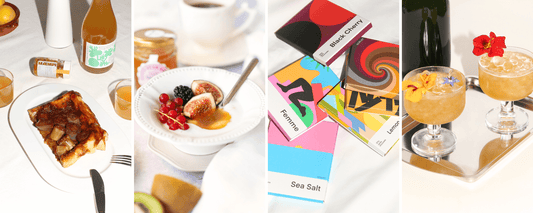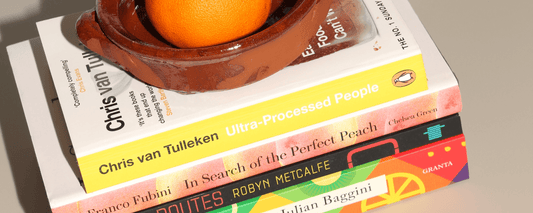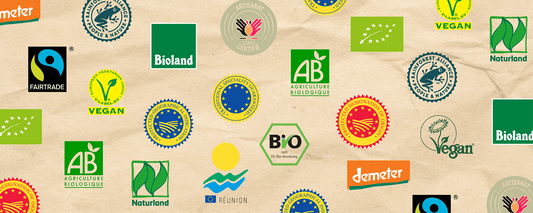Organic, Fairtrade, Regional, PDO – What Do Food Labels and Certifications Really Mean? A Guide for Conscious Choices
Shopping for food can be overwhelming when packaging is full of claims like "natural," "organic," or "fairtrade." But not all labels are created equal. Some are strictly regulated on EU or national level, while others are just marketing terms with no real standards behind them.
For anyone who values high-quality food, understanding food labels is essential. Whether you are looking for organic, ethically sourced, or authentic regional specialties, knowing how to read certifications—and how to look beyond them—helps you make better choices.
This guide breaks down the most important food labels in Europe, explains how to read ingredient lists effectively, and highlights common misleading claims to watch out for.
EU Organic Certification: What the Green Leaf Actually Guarantees

Organic food is often seen as a sign of higher quality—but what does the EU Organic Label actually guarantee? The green leaf logo of the EU Organic Label is a legally regulated certification that ensures strict standards are met at every stage of production, from farm to fork. Any product or farm certified under the EU organic scheme must comply with the following principles:
• At Least 95% Organic Ingredients
• No GMOs or Radiation
• Restricted Use of Chemicals
• Animal Welfare in Medication
• Natural and Ethical Animal Husbandry
Organic farmers also use methods that work in harmony with nature—such as crop rotation, green manure to restore soil health, and pest-resistant plant varieties to reduce or eliminate the need for chemicals.
It’s not only farms and producers that must meet these standards. Online retailers who sell certified organic products—like us at Gourmie Goods—are also required to go through the official certification process. We're proud to operate as a certified organic shop, so you can shop with full confidence.
It's worth noting that while organic products are produced more sustainably, the label doesn’t guarantee higher nutritional value—or that the product is completely free from additives. Some additives are still allowed under strict EU rules. Still, knowing what the organic label stands for helps you make cleaner, more conscious food choices—and brings you closer to the true origin of what’s on your plate.

Explore our curated selection of certified organic products on Gourmie Goods.
National Organic Labels in the EU: What They Add to the EU Standard
Even before the EU introduced a unified organic standard in 1991, countries like Germany and France had already developed their own organic labels—often with stricter criteria in specific areas. These national certifications still exist today alongside the EU Organic Label and frequently build on it with tougher enforcement and additional sustainability requirements.

Germany – Bio-Siegel
Introduced in 2001, the Bio-Siegel is a state-controlled label that supplements the EU Organic Label. While it follows EU organic regulations, it is backed by a more robust inspection system, with frequent checks carried out by accredited control bodies. In practice, it often ensures higher standards in areas like animal welfare—especially in dairy and meat production—where stricter husbandry conditions and access to pasture are commonly enforced.

France – Agriculture Biologique (AB)
First introduced in 1985, the AB label is managed by the French Ministry of Agriculture and remains a trusted mark of organic quality. It builds on EU organic standards by setting stricter limits on pesticide residues and requiring more extensive documentation on sustainability practices. The label also encourages local sourcing and shorter supply chains wherever possible.
While the EU Organic Label sets the foundation, these national certifications go a step further—offering more transparency, local accountability, and in some cases, higher standards. That’s something to keep in mind when choosing truly exceptional food.
Demeter, Bioland and Naturland: Highest Standard in Organic and Biodynamic Farming
For those looking for more rigorous standards than the EU Organic Label or national labels, several independent farming associations go further—particularly when it comes to soil health, biodiversity, and animal welfare. The most well-known are Demeter, Bioland, and Naturland, often referred to as “organic plus.” All three are based in Germany and build on the EU baseline with stricter criteria for both farming and processing.
These associations share core principles: closed-loop systems, long-term soil fertility, prohibition of synthetic fertilizers and pesticides, and species-appropriate animal husbandry. They also require the full conversion of the farm to organic methods—not just individual fields or product lines.

Demeter
Demeter is the oldest and most demanding organic farming association in Europe. Founded in 1924, it is rooted in biodynamic agriculture, based on the anthroposophical teachings of Rudolf Steiner. Farms must operate as living, self-sustaining organisms, where animal husbandry is mandatory to support soil fertility. Unique to Demeter, cattle must keep their horns, and farmers use special herbal and mineral preparations to support soil life. Demeter also has the strictest limits on processing and additives.

Bioland
Bioland is one of Germany’s largest organic farming associations. While not biodynamic, it holds high standards for sustainability, animal welfare, and soil health. Bioland farms must produce at least half of their own feed and are subject to stricter livestock density limits than EU organic rules. The focus is strongly regional, with an emphasis on short supply chains and environmental protection.

Naturland
Naturland combines organic agriculture with social responsibility. It includes additional standards for fair working conditions, transparency, and international development. It also certifies sectors beyond food, including forestry, textiles, and aquaculture. Like Bioland, it’s not biodynamic but shares similar ecological and animal welfare standards.
Vegan Labels: Certifying Animal-free Products
Unlike organic, the term “vegan” is not legally defined in the EU. That’s where independent labels come in. These seals help consumers trust that a product is truly free from animal ingredients — and often also from animal testing.

V-Label
One of the most recognized vegan symbols in Europe, V-Label is managed by the European Vegetarian Union. The label distinguishes between vegan (no animal ingredients or derivatives) and vegetarian (no meat, but may include dairy or eggs). Certification is handled by national partner organizations through strict ingredient and process checks.

The Vegan Trademark
Operated by The Vegan Society since 1990, The Vegan Trademark guarantees that a product contains no animal ingredients, hasn’t been tested on animals, and avoids animal-derived GMOs. It’s used on a wide range of food, cosmetics, and household goods.
Not All Vegan Foods Wear a Label
While these labels provide valuable orientation for mass-market and supermarket products, many high-quality artisan foods suitable for a vegan diet are not officially vegan-certified. Small, artisan producers often meet or exceed vegan standards but choose not to undergo the formal certification process due to cost or complexity.
Discover our curated selection of vegan-friendly specialties at Gourmie Goods.
Fair Trade and Ethical Labels: Do They Matter?
For consumers who prioritize ethical sourcing and sustainability, certain labels provide assurance—at least on the surface. Certifications like Fairtrade and Rainforest Alliance were created to improve conditions for farmers, workers, and the environment, especially in global supply chains for products like coffee, cocoa, tea, sugar, and bananas.

Fairtrade
Founded in 1988, Fairtrade works by setting a minimum price for certified goods, plus a premium that cooperatives reinvest in local development. It aims to support small-scale farmers in regions with weak labour laws, while also prohibiting child labour and encouraging safer, more sustainable farming practices. Fairtrade International works with nearly two million farmers and workers in almost 80 countries.

Rainforest Alliance
Rainforest Alliance focuses more on environmental impact—deforestation, pesticide use, and biodiversity loss—while also addressing social and economic conditions on farms. Its certification is often seen on tropical products and emphasizes long-term sustainability over pass/fail enforcement.
Where These Labels Fall Short
Despite their good intentions, both labels have clear limits. Farmers only benefit if a certified buyer exists. Environmental practices aren’t always mandatory. Biodiversity is often overlooked in favor of high-yield, monoculture crops. Audits are inconsistent and frequently announced in advance, making it easier to hide non-compliance.
Most importantly, these certifications don't guarantee living wages, worker empowerment, or complete freedom from child labour. They offer more transparency than conventional trade—but they don’t fix the root problems of poverty and exploitation. For many companies, especially the mass-market, industrial food producers, these labels have become a marketing tool—not a sign of meaningful change. They’re a step—but not a solution.
European Geographical Indications: What’s So Special?
Geographical indications in Europe protect the identity of regional foods and drinks—and help consumers find products that are genuinely rooted in place. These labels are more than just markers of origin: they reflect specific production methods, local know-how, centuries of culinary tradition, and legally defined standards. For those who value authenticity and craftsmanship, these labels provide assurance and preserve geographical heritage.

PDO – Protected Designation of Origin
PDO is the most strictly defined geographical label. It means that every stage of production—from sourcing raw ingredients to final processing—must take place in the named region. The methods used must also be traditional to that area. Well-known examples include Parmigiano Reggiano, Prosciutto di Parma, Roquefort, and Champagne.

PGI – Protected Geographical Indication
PGI is slightly broader in scope. It requires that at least one step—production, processing, or preparation—occurs in the defined region. The product must still carry a reputation or quality associated with its origin, but with more flexibility than PDO. Examples include Balsamico di Modena, Nürnberger Lebkuchen, and Westfälischer Knochenschinken.


TSG – Traditional Speciality Guaranteed
TSG focuses on traditional recipes or production methods, rather than regional origin. It protects food names based on how something is made, not where. Products like Neapolitan pizza and Serrano ham can carry this label if they follow specific preparation rules, even when made outside their historic region.

Products of the EU’s Outermost Regions
This label applies to food and agricultural products made in the EU’s outermost territories—like the Canary Islands or Réunion. It helps maintain traditional practices in these remote areas while ensuring they meet EU-wide standards for quality and traceability.
How to Read an Ingredient List Like a Pro
While food labels can indicate quality, the ingredient list often reveals even more. In the EU, ingredients must be listed in descending order of weight, meaning the first few ingredients make up most of the product. That’s your first clue to what you’re really eating.
Fewer Ingredients, Better Food
A shorter ingredient list is often a sign of better quality and less processing. That’s also one of our key sourcing principles at Gourmie Goods—we believe less is more. A good tomato sauce, for example, should be made with just a few ingredients: ripe tomatoes, olive oil, a pinch of salt, and maybe some herbs like rosemary or basil. No added sugar, no thickening agents, no preservatives.
Watch Out for Hidden Sugars
Sugar doesn’t always show up as “sugar” on the label. It can appear under a range of names—like glucose syrup, maltodextrin, fructose, or even “fruit concentrate.” These hidden forms are common in everything from salad dressings to sauces. If sugar is listed near the top of the ingredient list, especially in savoury or supposedly healthy products, that’s usually a red flag.
Look at the Key Ingredients
It also helps to check the percentage of key ingredients. If you’re buying dark chocolate, for example, cocoa mass should be listed first—not sugar. The same applies to products like pesto (where basil or nuts should come first) or fruit spreads (where fruit, not glucose syrup, should dominate).
Common Misleading Claims to Watch Out For
Some food labels are designed to sound more impressive than they really are. This is especially common in supermarket products, where industrial food companies often use unregulated terms to suggest quality or health benefits. It’s always worth checking who’s actually behind the product. If it’s a small producer in the south of France, “artisan” might mean something; if it’s a multinational like Nestlé—it likely doesn’t. These terms can be misleading, but with a bit of attention to the details—like the ingredient list or producer info—you can cut through the noise and make more informed choices.
“Natural”
This term has no consistent legal definition in many countries. It doesn’t mean a product is organic, minimally processed, or free from additives. A product labelled “natural” can still contain flavour enhancers, preservatives, or non-organic ingredients. Always check the ingredient list—it’s the most reliable way to see what’s actually inside and how natural a product really is.
“No Added Sugar”
This doesn’t mean the product is sugar-free. It may still contain naturally high levels of sugar from ingredients like fruit juice concentrate, date syrup, or other sweeteners. Always check the ingredient list and nutrition panel for context.
“Made with Whole Grains”
Products with this label may contain only a small amount of whole grain while still being mostly refined flour. To understand what you’re really getting, look for whole grain ingredients listed at the top—or check for percentages where available.

“Artisan” and “Handmade”
These terms are commonly used as marketing language and are rarely regulated. They don’t necessarily mean the product was made using traditional methods or in small batches. An exception exists in Belgium, where the government issues a formal label—Artisanat Certifié (Erkend Ambacht)—to certify authentic Belgian artisans.
Shop Artisanat Certifié certified products on Gourmie Goods.
Making Smarter Food Choices
Understanding food labels is an important step toward choosing better products, avoiding misleading claims, and enjoying truly high-quality food. But no single label or certification can guarantee outstanding quality on its own.
The most reliable indicators? Check the ingredients—and check who’s behind the product. Small-scale producers who grow their own ingredients and craft everything in-house are far more likely to prioritize quality, integrity, and taste over shortcuts.

At Gourmie Goods, we believe that great food starts with great ingredients and the people who know how to work with them. That’s why we carefully select products from the best artisan producers across Europe—many of whom grow, harvest, and make everything themselves.
Next time you shop for food, use this guide to decode labels and ingredient lists. And if you're looking for truly authentic, clean-label foods made by passionate producers, explore our curated selection.
Shop certified organic, regional, and small-batch products from Europe's best artisan makers on Gourmie Goods.

About author
Baiba Soika
Food writer and Co-founder of Gourmie Goods, Baiba is dedicated to putting good food at the center of modern living, believing food is the foundation of a successful life. With a background in international trade, design, and technology, she brings a unique, multifaceted approach to food industry. When not sourcing products or exploring new brands and trends, you'll find her somewhere near the sea, on the badminton court, doing sudoku, or in the kitchen, crafting simple yet flavorful dishes. Based in Düsseldorf, Germany.





